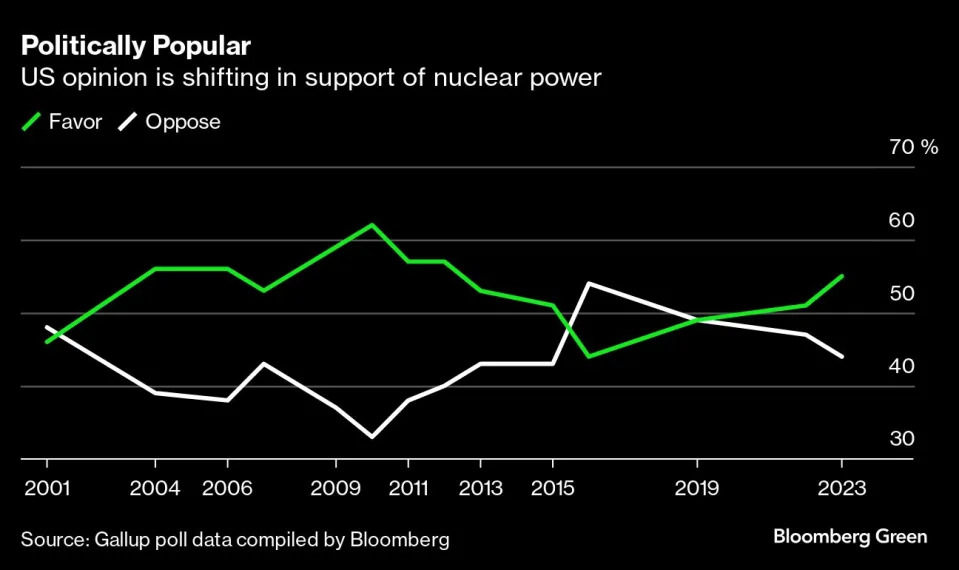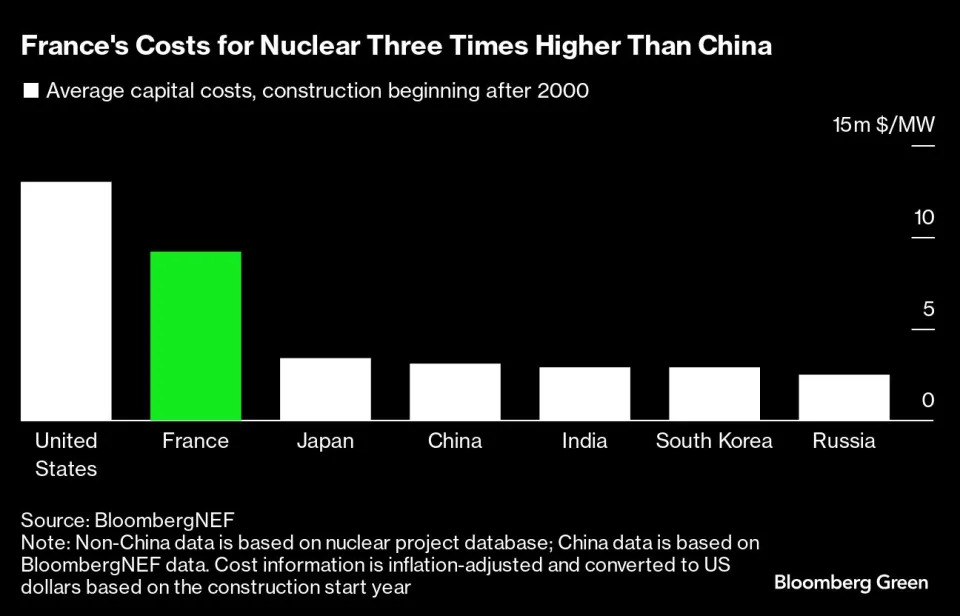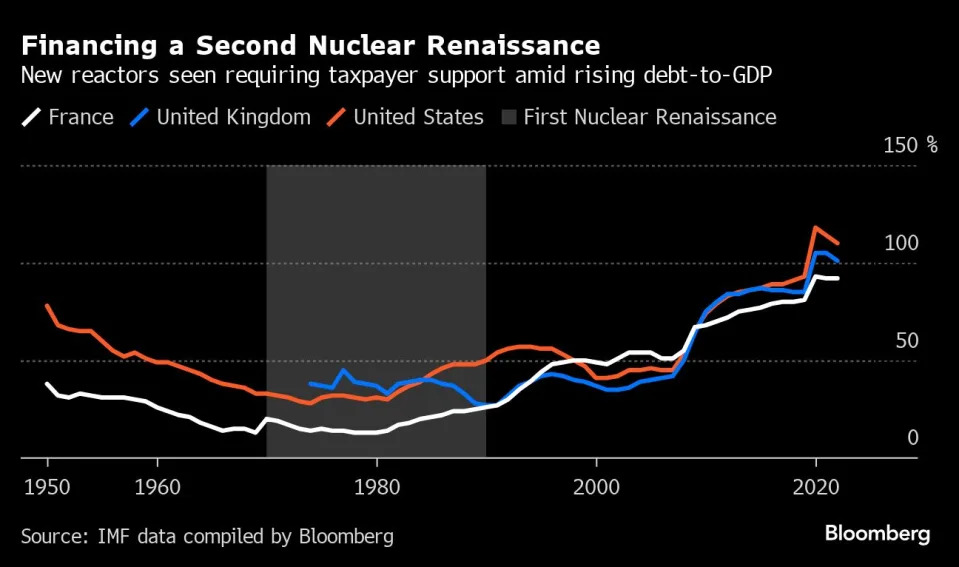IT HAS NO FUTURE WITHOUT THEM
CAUSE US TAXPAYERS AIN'T FOOTING THE BILL
Jonathan Tirone
Fri, 14 June 2024



3 / 3
Building Nuclear Power Is a Bridge Too Far for World’s Private Investors
(Bloomberg) -- The next generation of nuclear reactors will need to be financed by taxpayers because private investors aren’t willing to bear the risks associated with building new plants.
Beaches on Singapore’s Sentosa Island Hit By Oil Spill
That was the warning from bankers at a meeting of industry and government officials in Prague this week. The Nuclear Energy Agency event underscored the hard decisions Western economies soon need to make to keep one of their biggest clean energy sources going. While the public have warmed to nuclear in recent years, spiraling project costs have made private equity cautious.
Officials have estimated that the world needs to spend $5 trillion to triple nuclear-power generation over the next 25 years. The problem is that years of delays and billion-dollar budget overruns at European and the US projects are spooking investors, and scores of reactors already running on borrowed time will need to be replaced. No private investors want to take on construction risks, said Simon Taylor, a financier at the Cambridge Nuclear Energy Centre.
“We’re at a critical juncture of in the history of nuclear energy,” said William Magwood, director general of the Nuclear Energy Agency. “We have to move quickly. Financing is critical.”
Earlier this year, Electricite de France SA said its nuclear project at Hinkley Point in the UK would cost as much as £10 billion ($13 billion) extra to build and take several years longer than planned. In the US, Southern Co.’s Vogtle nuclear facility came in more than $16 billion over budget and seven years behind schedule.
“Unfortunately, the nuclear industry has been its own worst enemy,” said Anurag Gupta, chief risk officer at Sequoia Investment Management Co.
While some private capital has gone toward designing small modular reactors — factory-built units theoretically cheaper to build than traditional plants — those projects have also been plagued by delays pushing full commercialization years later than expected. That leaves nuclear advocates struggling for investor support with the technology at hand.
Rothschild & Co.’s Steven Vaughan, an adviser for UK’s proposed Sizewell C nuclear plant, echoed the view that investors are wary of taking on exposure to construction risk.
Equity investment interest in Sizewell, currently owned by the UK government and minority stakeholder EDF, has been muted, with Centrica Plc suggesting it could become a stakeholder.
Compounding nuclear power project risks are the long life span of the assets and the uncertain development of electricity markets. Historically, nations alleviated that risk by building reactors themselves. That’s still the case in China and Russia — the two countries building the most plants.
“It’s hard for any investor to think about market design 50 years into the future,” said Iain Smedley, chairman of global banking at Barclays Plc. “It’s therefore very important they’re comfortable with the social contract.”
Some delegates in Prague suggested economies need to think about nuclear power beyond simply profit and loss. It’s an emissions-free energy source that can help meet climate targets, as well as supporting a skilled workforce.
“There is a vast need for state involvement,” said Marcin Kaminski, risk manager building Poland’s first reactors at Polskie Elektrownie Jadrowe.
Bloomberg Businessweek
U.S. Pushes to Triple Nuclear Energy Production by 2050
Editor OilPrice.com
Sat, 15 June 2024 at 11:00 am GMT-6·3-min read
This Monday Michigan Governor Gretchen Whitmer announced that she intends to reopen a nuclear power plant to meet the state’s decarbonization goals. If she is successful in her campaign, it would mark the first time in United States history that a nuclear power plant has been brought back online after being decommissioned – but it more than likely won’t be the last.
The owner of the Palisades Nuclear Generating Station, which currently sits dormant on the shores of Lake Michigan, received a conditional loan guarantee for a whopping $1.52 billion from the U.S. Department of Energy’s Loan Programs Office to help fund the plant’s revival. If Holtec, the company that owns the plant, meets all of the closing conditions, the Palisades plant would be just the second or third plant in the entire world to be re-commissioned. And they plan to do it by just 2025.
Reopening the plant would not only be a trailblazing boon for low-carbon energy production in the United States, it also stands to offer a huge economic boost to Michiganders, who lost more than 600 high-paying jobs, many unionized, when the plant shuttered in May 2022. Whitmer says that if the plant is restarted, it could bring in $363 million in much-needed regional economic impact.
Although the United States has the top-producing nuclear energy fleet in the world, the country’s nuclear power sector has been in decline for years. The average age of a nuclear reactor in the United States is about 42 years old. Around one dozen nuclear power reactors have closed in the United States since 2013, and according to the U.S. Nuclear Regulatory Commission, 22 commercial nuclear power reactors (out of 93 total reactors) at 18 sites are in various stages of decommissioning. Meanwhile just one new power plant – Georgia’s plant Vogtle – has been added to the national fleet in the last several decades. And at present, zero new reactors are under construction in the United States.
The United States will have to see a radical repositioning and revitalization of the nuclear power sector if it is to meet its own global pledges, which includes a commitment to triple nuclear power production by 2050. At last year’s COP28 global climate conference, the United States was one of more than 20 countries that cooperated to launch the Declaration to Triple Nuclear Energy.
Building new power plants is extremely cost-prohibitive, however. And Plant Vogtle has shown just how expensive and exhausting building up a new nuclear fleet could be. First approved in 2009, it has only just reached completion, with its fourth reactor finally coming online on April 29, 2024, when it officially became the most expensive infrastructure project of any kind in U.S. history, at a whopping $35 billion. “The project has been such a bloated disaster that many pundits think it could be make-or-break for the wholesale future of the United States nuclear sector,” Oilprice reported in April.
So instead of investing hundreds of billions of dollars into building out a new nuclear fleet from the ground up, why not bring a fully formed industry back from the grave? Or better yet, if the country is to have any hope of meeting that lofty triple nuclear energy pledge, why not both? Many of the defunct nuclear power plants in the United States are too far gone to restart, but even rebuilding a new reactor on the same site would be a huge advantage for efficiency and cost-effectiveness. “So you don’t have to go through the whole rigamarole again, you can just use the existing footprint to be able to increase generation capacity,” Energy Secretary Jennifer Granholm was recently quoted by Fast Company.
Building new reactors as an expansion of existing plants can be another cost-effective alternative, which many companies are already taking advantage of. Granholm says that about 30 such power plant sites across the country have already been licensed or permitted for the construction of more reactors.
By Haley Zaremba for Oilprice.com
No comments:
Post a Comment